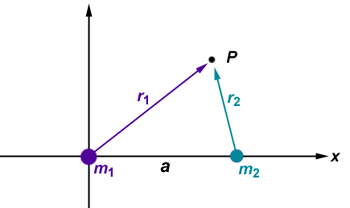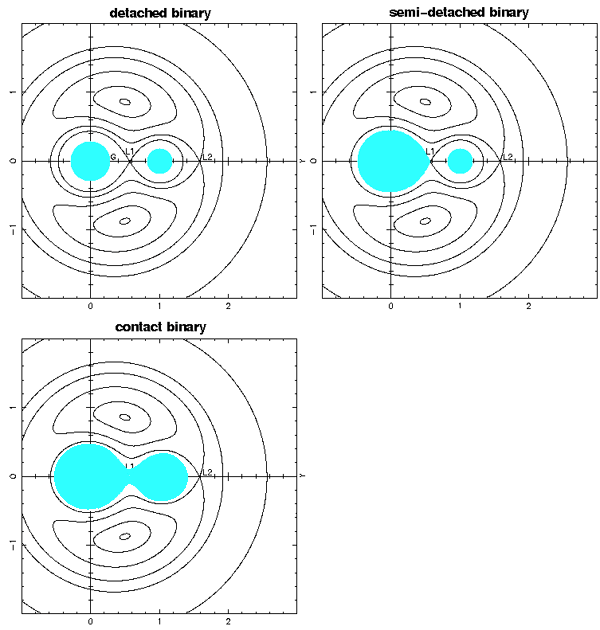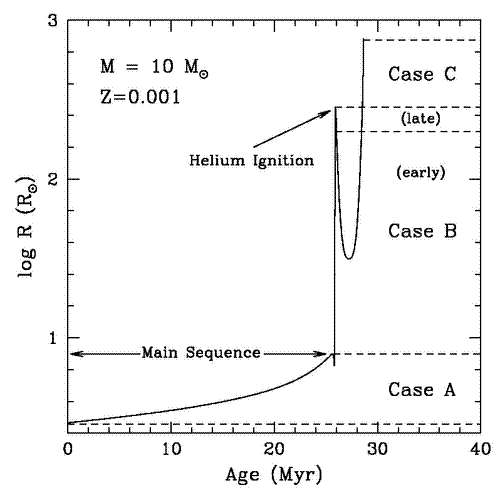
The Roche potential
First, consider the orbiting gravitational potential that a binary system
finds itself in.
It is often useful to use the co-rotating potential, particularly
for close binaries that are likely to be rotating synchronously.
Assume that the stars are point masses (a good assumption as far as the
outer layers are concerned) in circular orbits.

The two masses are m1 and m2, separated a distance a. Center a rectangular coordinate system on m1, with x directed toward m2 and y in the plane of the orbit. Then we may write:
ω 2 = G (m1 + m2)
/a 3
r 12 = x 2 + y 2 +
z 2
r 22 = (x − a)2 +
y 2 + z 2
q ≡ m2 /m1 , q ≤ 1
xcm = aq /(1 + q)
Φ = − (Gm1 /r1)
− (Gm2 /r 2)
− ω 2 [(x − xcm )2
+ y 2] /2.
The gradient of the last term is the centrifugal force experienced in a co-rotating frame. Expressing all distances in units of a and Φ in units of G (m1 + m2) /a, we may write the dimensionless potential as
ΦN = − 2/(1 + q) r 1 − 2q/(1 + q) r 2 − [x − q/(1 + q)]2 + y 2,
which depends only on q. Here is a contour plot of the potential surface in the orbital/equatorial plane.

The L's in the figure above mark the Lagrangian points, assuming the
figure is rotating counter-clockwise.
L4 and L5 always form equilateral triangles with
m1 and m2.
Note: while L4 and L5 are tecnically unstable
equilibria in a co-rotating frame,
for q < 0.0401 bodies that slip off this
'hill' and therefore aquire relative motion feel coriolis
forces that cause them to orbit the Lagrangian point slowly.
Thus the Greek and Trojan asteroids.
Binaries are physically classified according to the following diagram:

There is inconsistancy in the literature concerning the last catagory-
this author has been brought up to label any configuration filling an equipotential
between L1 and L2 a 'contact binary'.
Some label only the configuration that just touches at L1
'contact', and any more serious contact 'common envelope'. I and others reserve the
term 'common envelope' to describe two nuclei orbiting within a non-synchronous
envelope of much larger size.
Radial aging of a single star indicating types of Roche lobe overflow:

Eclipsing binaries:
EA (Algol)
EB (Beta-Lyrae)
EW (W UMa): further divided into A- (AW UMa prototype) and W- (W UMa prototype) types.
A-type are spectral type A and earlier, have smaller and various q, behave "normally", e.g. transit minimum is deeper.
W-type are spectral type F and later, have q ≈ 0.5, occultation minimum deeper.
Light curves from
AAVSO Eclipsing Binary Workshop.
A series of light curves, mostly W UMa type.
Algol paradox: low-mass star is the aged ('evolved') star, filling Roche lobe and transfering
mass to the high-mass star.
Result of mass transfer with conservation of angular momentum:
1. More massive star swells to fill Roche lobe.
2. Transfer from more massive to less massive → decreasing separation, decreasing
lobe size, more transfer. Runaway process.
3. Toward the end, when the masses are nearly equal, →
Beta-Lyrae type.
4. When mass inequality reversed, transfer → incresing separation. Pair now ages
on the nuclear timescale of the original primary → Algol type.
5. Original primary ages to compact remnant (WD, NS, or BH).
6. Original secondary swells to Roche lobe, spills onto compact object.
6a. If WD, → various cataclysmic variables including novae.
Possibly ends as supernova type Ia.
6b. If NS or BH, → binary X-ray source.
7. Two compact remnants in orbit, decaying by gravitational radiation.
All about Algol.
Interactions
Binaries may interact via:
Winds:
colliding winds in early-type stars, wind accretion in high-mass Xray binaries,...
Luminosity: surface heating by a companion X-ray source, photoionization of the wind in symbiotic stars,...
Magnetic Fields: the strong stellar magnetic field in AM Her stars...
Binary Separation/contact: tidal effects in close binaries- large tides, distorted winds,
synchronization, mass transfer,...
Hydro calculations.
Mass transfer with a stellar wind.
High-mass X-ray binaries.